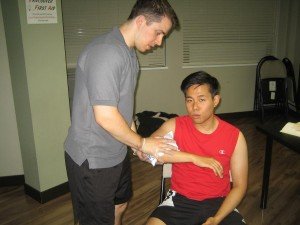When an individual bends the elbow, you can readily sense the bony protrusion that starts from one of the inferior arm bones which is known as the olecranon. It is positioned directly under the skin of the elbow which lacks protection from muscles or other soft tissues. Remember that this can easily break if subjected to a direct blow to the elbow or fall on a bent elbow.
Potential causes
There are various types of elbow fractures and they usually occur in isolation and can be part of a complex injury. The elbow fractures can occur in various ways which includes the following:
- A direct blow can occur during a fall or being struck by a hard object.
- An indirect fracture can occur when the individual lands on an outstretched arm. The individual falls on the wrist while the elbow is locked completely in a straight position.

swelling over the affected site.
What are the symptoms?
- Abrupt, intense pain
- Swelling over the affected site
- Inability to straighten the elbow
- Bruising around the elbow
- Numbness in one or more fingers
- Tenderness to the touch
- Pain with joint movement
By enrolling in a first aid course, you can learn measures to help ease the discomfort of this injury.
Diagnosing an elbow fracture
An individual with an elbow fracture should be taken to the emergency room since it can cause intense pain and inability to move. During the examination, the doctor will perform the following:
- Assess the skin if there are any lacerations.
- Palpate the area around the elbow to determine if there are areas of tenderness.
- Assess the pulse at the wrist to ensure that there is good flow of blood going through the elbow up to the hand.
- Assess if the fingers or wrist can be moved and if the individual can feel with his/her fingers.
- The elbow is straightened. The individual can do this or not.
- The shoulder, forearm, upper arm, wrist and hand are examined.
An X-ray is performed to confirm if a fracture occurred. This will reveal other possible fractures or dislocations. The upper arm, shoulder, forearm, wrist or hands are also checked by an X-ray depending on the complaints of the individual. The X-ray results can reveal other injuries as well.
Treatment
When the individual is taken to the emergency room, the doctor will manage an elbow fracture with application of ice, pain medications and a splint or sling to keep the elbow in its proper position. Whether or not the fracture entails surgery is determined. Remember that not all elbow fractures need surgical intervention.
In some cases of elbow fractures, it would only require a splint to hold the elbow in its proper place during the healing process. The doctor will carefully monitor the healing and would require regular X-rays. If the bones are in place, the doctor will start to move the elbow gently which would require visits with a physical therapist.
The non-surgical approach to an elbow fracture might require extended periods of casting or splinting. The elbow can become stiff and entails a longer period of therapy after the cast was removed to regain motion. In case the fracture shifts its position, it would require surgery in order to put the bones back in place.
